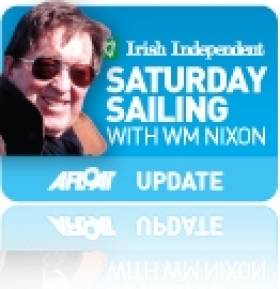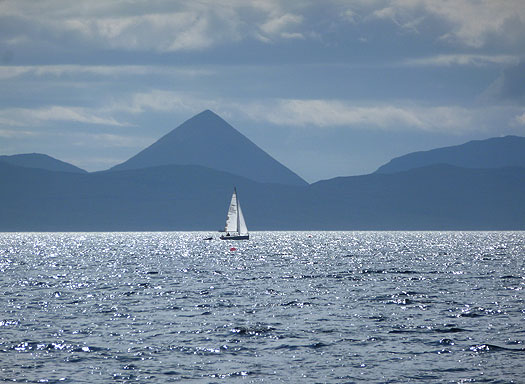Displaying items by tag: Derrynane
It was in 1828 – 178 years ago - that a regatta sailed at Kilrush led to the formation the Royal Western Yacht Club of Ireland writes W M Nixon. Ten years later, the new club was thriving with a fleet of 18 substantial yachts based in Kilrush Creek. While the members sailed and cruised on the Irish coast southeast around to Cork Harbour and north to Galway, their focus was mainly on northwest Kerry, with the club maintaining a “Station” at Tralee
One of the families most prominent in the RWTC of I’s establishment were the O’Connells of Tralee, Cahirsiveen and Derrynane, the leading role being taken by Maurice “Hunting Cap” O’Connell. He was the prime mover in creating the 1828 gathering at Kilrush, while his nephew Daniel O’Connell of Derrynane, The Liberator, was also an active member.
The depredations of the Great Famine of the 1840s wiped out virtually all yachting activity on the west coast, but a few yachts of the old RWYCoI were moved in very reduced circumstance to Ireland’s east coast. By this stage Daniel O’Connell’s political work in combatting the Famine was taking up much of his energy, but when on the 4th July 1846 a meeting was held in a Dublin hotel to re-establish Dublin Bay’s Royal Irish YC of 1831, Daniel O’Connell was one of those present to ensure that the club in its reborn form had moved on to properly accommodate the most ancient Irish aristocracy, together with the rising Dublin Catholic middle class, and other religions whose adherents were hampered in their sailing by not being of the Established Church, people like Quakers and Presbyterians.
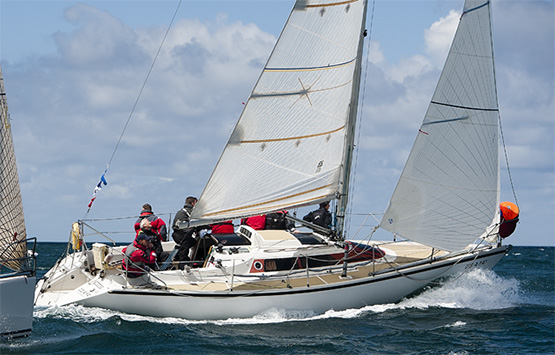
The McGibney family’s Dehler Dis-a-Ray from Tarbert in the Shannon Estuary is expected to be one of the favourites
This re-birth of the RIYC was a remarkable declaration of faith and national optimism in a very dark period, and the fact that its iconic new waterfront clubhouse had been built beside Dun Laoghaire harbour by 1851 was symbolic of the slow emergenece from the horrors of the famine.
Yet despite this successful new development, some members of the old Royal Western Yacht Club of Ireland kept the faith with their ancient if now decidedly threadbare and homeless club. Although some reports would assert that the RWYC of I was wound up in Cobh, of all places, in the 1870s, in Kilrush the Glynn family continued to maintain that the RWYC of I had never died, and they continually added to their already significant collection of old club memorabilia, minute books and other documentation.
So when a near-miracle occurred with Shannon Development bringing Kilrush Marina into being in 1991, securely sheltered within its tide-retaining breakwater and accessed via a sea-lock, a club of some sort was needed by the sailing cruisers using the welcome new facility. While they initially called it the Western Yacht Club, it soon became the Royal Western of Ireland, complete with the authentic colours of 1828 as cherished by the Glynns, and from tomorrow (Wednsday June 29th) through to Saturday July 2nd, the RWYC of I is hosting the WIORA West of Ireland Championship, with a fleet of 30 boats mostly from the Atlantic seaboard competing.
The visitors will find that the host club can provide an unusual link with its distant past, as current Commodore Adrian O’Connell is directly descended from people related to the founders. A distant but direct ancestor was a second cousin of Daniel O’Connell, and that ancestor’s sister Mary O’Connell became Mrs Daniel O’Connell.
Families are very much the thing in Shannon Estuary sailing, as the renowned McGibney family of Tarbert, whose home club is at Foynes, will have three boats racing. Irish Cruiser Racing Association Commodore Simon McGibney tells us that the McGibney campaign will be spread across all three, with the family’s well-known Dehler 0ptima 101 Dis-a-ray being supported by a J/24 and a GK24.

Barry Heskin & partners with the Dubois 34 Nowwhat (GBSC) were runners-up in Division 1 IRC in the 2015 WIORA Championship
WIORA will be celebrating its 40th Anniversary with this championship, which over the years has been staged as far south as Tralee Bay SC, and as far north as Mayo SC on Clew Bay. Kilrush is looking well for the brithday celebrations, as the harbour complex has been bought over and re-furbished by noted marine-specialising civil engineering firm L & M Keating, with Kim Roberts as Marina Manager. L & M Keating is headquartered in nearby Kilmihil, but is active on projects throughout Ireland, and the firm is supporting the WIORA Championship with Kilrush Credit Union as main sponsors. Racing starts tomorrow, meanwhile here’s the results of last year’s breezy championship in Galway Bay:
WIORA West of Ireland Championship 2015
Division 1 IRC
1 Joie De Vie, Silvie Blazkova/Cahill G, (J/109 Galway Bay Sailing Club)
2 NowWhat, Barry Heskin (Galway Bay Sailing Club)
3 Xena , Ian Gaughan, (Mayo Sailing Club)
Division 2 IRC
1 Tribal, Liam Burke, (Corby 25 Galway Bay Sailing Club)
2 Dis-a-Ray, Raymond McGibney, (Foynes YC)
3 Treyona, Finbar O'Connell (Tralee Bay SC)
Division 3 IRC
1 Jaguar, Gary Fort, (Tralee Bay SC)
2 Battle, JP Buckley, (FoynesYC)
3 Running Tide, Michael Mulloy (MayoSC)
White Sails
1 Jabiru, Pat O'Shea, Jim Lawlor (Royal Western YC)
2 Poitin, Bev Lowes ( Foynes YC)
3 Zephyr, Kieran Ruane, (GarrykennedySC)
Sails and the City
#americascup – It's time for the reality check in San Francisco. This morning, season tickets guaranteeing "the best seats on the bay" for the America's Cup 2013 go on sale. The America's Cup Season Pass includes a ticket to the choicest seating in a prime waterfront location at the America's Cup Village, with an elevated close-up view of the race start and the top turning marks of the course.
Perhaps talk of a "reality check" is pitching it too high. They'll sell out, as did the tickets to the same locations for the preliminary on-the-water sparring during 2012. But for those running the project, whether directly involved in everything to do with the sailing, or in the background co-ordination of the city's participation, each and every last pointer to the marketability of the ultimate sailing event is going to be closely analysed. The hope will be that conclusions can be drawn as to whether or not it's possible to generate enough interest in viewable sailing to make waterfront communities get more committed to it at official level.
So it's not a question of whether or not the tickets sell out. Rather, it's a matter of how quickly, and to whom, and for how much. The economic interaction between sailing and cities is extremely difficult to quantify, so the goldfish bowl which is the America's Cup in the Bay City will provide an excellent opportunity for gauging public interest, and where it all might go.
As it is, the city fathers in San Francisco are having quite a bumpy ride with the America's Cup. It took all sorts of negotiations and deal-making to secure civic backing to let the big sailing circus happen in the bay in the first place. Since then, a public appeal to build up a $20 million non-profit organisation to underpin the staging of major sporting events in the city, starting with the America's Cup, has been greeted mainly by silence – and it's not the agreeable silence of hundred dollar notes floating into plastic buckets.
San Francisco mayor Ed Lee is still in the early stages of creating this promotional organization, called OneSF, but if the America's Cup fails to hit its earning expectations, the hope of attracting events like the Superbowl in the near future will be severely hampered.
Coming as it does in the week when the Volvo Ocean Race organisation confirmed the list of ports round the world which will be hosting its stopovers in the next staging of the circumnavigation, it's of special interest. We're now getting a plethora of information as to which cities are hitting the target. But other than that they all want to do it, it's difficult to discern a shared pattern for success.
And when you add the complexities of big city politics, it can be anybody's guess as to what makes for the magic formula. But for the Volvo stopover wannabees, I'd suggest that being the finishing port is not a winning proposition. This seems to have been underlined by Galway's two experiences with the race. The first time round when Galway was a stopover, admittedly it was still something of a novelty, and we weren't stony broke. But the fact that there was still racing to be done gave it a special dynamic.
Second time round, you'd have thought Galway being the finish port would have done the business, but precious little business was done. The buzz wasn't the same. The national economic situation was dire and the weather was crap, and today the unhappy legacy of ill feeling still lingers on. There was no strong sense of the city, apart from the immediate harbour area, benefiting in any way.
There have been all sorts of explanations. In the economic extremities of the time, it's even possible that Ireland's new road system played a part. The Dublin to Galway motorway was unfinished for the first Volvo visit. But it was very much up and running the second time round. Thus economically stressed families in the capital could contemplate a day visit to Galway and get all of the excitement of the Volvo Ocean Race show without spending a cent in the western city, and still be comfortably home that same night. All they needed was a tankful of diesel for the people carrier, and enough cash for the road tolls. Crazy theory maybe, but who knows.....
By the same token, the Tall Ships in Dublin at the end of August was a gift for financially-stretched families. So much of it was just one great big free show, and though there was one day of awful weather, the rest of it had as good weather as the summer of 2012 could provide. So the citizens were happy with their free maritime show. And a happy citizen is a happy voter, so the city fathers were happy. But whether or not the traders were happy is another matter, though heaven knows those on the quaysides charged enough for snacks which would have been half the price in a normal retail outlet.
Yet for those who party, it was a marvellous excuse for a party. There are times when the sailing events into which we all put so much thought and effort in order to chime with public interest are simply seen by Joe Public as no more than a good excuse for a party. And when it's not convenient to party, interest is zero. One setting where you'd think sailing and public interest would comfortably interact is during Cork Week, when the fleets on the in-harbour courses are racing in dramatic style close in on the Cobh waterfront. It's so good you'd think they could sell tickets to those who want to watch. But in truth there are probably more people on the boats admiring Cobh than there are people ashore in Cobh bothering to look out at the racing.
I'd a telling insight on general interest in sailing at Wicklow during the start of the Round Ireland Race in June. While there was the usual crowded buzz around the harbour and Wicklow SC, I reckoned a better overview could be had up the road at Wicklow Golf Club.
Well, it hit the spot perfectly. So perfectly, in fact, that when the good times return, if you happen to be involved in organizing some sort of corporate function associated with the start of the Round Ireland Race, then see if you can cut a deal with the golf club. They've a bit of space, and there's a splendid view of the entire starting area and the first mile or so of the race itself.
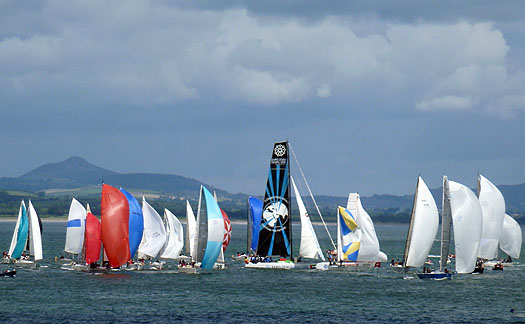
The start of the Round Ireland Race 2012 as seen from the clifftop tee at Wicklow Golf Club Photo: W M Nixon
Best view of all is at the tee which is right on the clifftop. There happened to be a four ball driving off as the last minute ticked away to the start. It took me a bit of overuse of the zoom lens to get a pic, yet it still made a double-page spread for the Afloat Annual. But as for the four happy golfers who could have enjoyed the best view possible of the start of the Round Ireland Race – they didn't take a blind bit of notice. When people bang on about making sailing accessible and visible to all, I sometimes think of those golfers. But maybe that's not quite fair. Golfers are a different species. If there'd been a golf course on Cape Trafalgar on the 21st October 1805, I don't think anyone playing on it would have noticed anything at all unusual out at sea on that particular day.
DERRYNANE STAYS IN BUSINESS
Derrynane in far southwest Kerry must be Ireland's most complete cruising anchorage. It's utterly beautiful, it provides perfect natural shelter, its feeling of being away from it all is total, and ashore there's everything you could want, from superb beaches and glorious walks, to a perfect pub nearby.

Derrynane, probably the most complete cruising anchorage in Ireland. Photo: W M Nixon
But that's only the start of it. The place is suffused in history and topical interest. It's the home port of Damian Foxall, and in times past it was the summer sailing base for Conor O'Brien of Saoirse fame, whose signature you can see in the guest book at Keating's pub. And the Dunraven family of America's Cup notoriety also had their summer place at Derrynane.
Before that again, it was of course the ancestral home of Daniel O'Connell, The Liberator, and a run ashore would be given added depth with a visit to his family's Derrynane House, which has been entrusted to the nation since 1964. Despite its setting near the sea, it slumbers in an almost tropical torpor, an architectural mishmash of considerable charm. And for sailing folk, it has added interest in that O'Connell was himself a sailing enthusiast, co-founder of the Royal Western YC at Kilrush in 1829, and one of those who re-started the Royal Irish YC on 4th July 1846.

Ancestral home of a sailing man. Derrynane House is "an architectural mishmash of considerable charm"
A week ago, however, it was announced that Derrynane House would be closed for six months from April 2013 for a major re-furbishment on which €1.2 million would be spent. I marked it down as an item of information to be included this week for anyone cruising the southwest who would normally plan a visit to Derrynane and the house in their programme. But the good people of the neighbourhood, many of whom are involved in the hospitality industry, have decided otherwise.
Righteous indignation is a marvellous energizer, particularly when it is genuinely righteous. When you think of it, of course, there is nothing more absurd than planning to close the jewel for visitors in the neighbourhood crown right in the middle of the year of The Gathering. Whatever, the quiet roar of righteous indignation from the people of Derrynane and Caherdaniel blew away all the nonsense of closure this summer, and the re-furbishment is being re-planned to happen outside the summer season.
If the re-furbishment programme is being re-structured, maybe they can expand it to include a major tidy-up of the ancestral graveyard down by the harbour. Things may have improved in it recently, but I was there last Easter, and it was in a disgraceful condition.
SHACKLETON IS SOMETHING ELSE
Those who re-create the astonishing 800 mile voyage by Ernest Shackleton and his men in the sailing lifeboat James Caird from Elephant Island to South Georgia have tended to add even further to the lustre of Shackleton and his shipmates. Their voyages have usually been in the Antarctic summer, whereas the original epic passage took place in late April and early May, which would have been the equivalent of undertaking a major Arctic voyage in the 22ft boat at the beginning of November.
Thus the recent successful Caird voyage by Tim Jarvis and his shipmates is the same as an Arctic voyage at the end of July. But that is still a great achievement by most standards. It's just that Shackleton's voyage was so far beyond our comprehension that we needs must grasp at anything which will put it in context.
He and his shipmates were superhuman, and none more so than Tom Crean. Even the most casual study of life aboard shows that Crean was central to the survival of all. Anyone who has ever tried to heat a cup of coffee in heavy weather on a comfortable cruising boat at sea will have some appreciation of Tom Crean's efforts in ensuring that everyone on board the tiny vessel had one life-saving mug of hot milk every night.
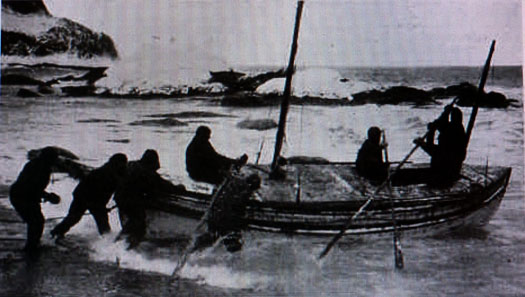
Not yachting as we know it...Ernest Shackleton and his crew launch the tiny James Caird at Elephant Island as the Antarctic winter starts to set in on April 24th 1916.
It's absurd to compare the superhuman task of heating milk aboard the James Caird with your average yotty's heavy weather experiences, but as it happens, in a sense this was a yachting venture which happens to chime with something done by Conor O'Brien from our Derrynane story.
After he returned with his Baltimore-built Saoirse from his circumnavigation in 1923-25, Conor O'Brien received an order from the Falkland Islands company for a larger version which would become the inter-islands trading ketch Ilen. Ilen was built in Baltimore (she's back there now, being restored at Oldcourt) and in 1927 O'Brien was to sail her out to the Falklands. But the only way he could get insurance was if she was registered as a yacht, so it was Ilen RIYC, complete with burgee, which sailed to the south Atlantic.
With Ernest Shackleton and the Endurance, while everyone wanted him to sail under the white ensign as befitted a national hero who should have been part of the Royal Navy, there were technical objections. But it was neatly solved by Shackleton becoming a member of the Royal Yacht Squadron and Endurance went to Antarctica as a yacht of the RYS, entitled thereby to fly the white ensign.
NAOMH BAIRBRE RUMBLES ON
There is only one thing more boring than a sailing boat under motor, and that is a sailing boat under motor in the rain. But we had a lot of that on Thursday night on TG4's Turas Huiceara, the six part series on Thursdays at 9.30pm which traces the voyage of the 47ft Galway hooker Naomh Bairbre along the Celtic seaways to the north of Scotland and back to Connemara.
Last week we'd left Donncha and the lads in Castlebay in Barra with a double whammy. Their main boom – all 34ft of it – had broken. And in TG4 HQ somebody had forgotten to switch on the sub-titles button, which as Donnacha mentioned in his response here on Monday, had baffled everyone – apparently even some fluent Irish speakers were having difficulty understanding the Barra Gaelic.
Not all, though. Anyone who polished up their Irish in the Gweedore Gaeltacht in Donegal would have had no problem. Many years ago I was out in Barra with Johnny Roche in his South Coast One Design Safina (super little boat, she's based in Poolbeg these days, owned by John B Kearney's nephew) and one of our crew was Denis Drum, purveyor of fine art to the gentry, and world class chef. Denis noted the little fishing boats landing lobster and crab in abundance, and decided to get some, but the guys in the pub told him the story that all the catches go straight to Paris for the highest prices, and that he'd no chance.
Nothing daunted, Denis went down and turned on the old charm, but no success. So he switched on his Irish sub-titles button, waxing lyrical with the old tongue he'd learnt in Gweedore. It was magic. He was given as much shellfish as we could possibly need, and more, and all for free. There was so much that a cockpit locker lid had to be used for the serving dish. We were up to our ears in lobster and crab for several days. So Barra-speak can be understood in Ireland.
But not by most of us, and maybe it's just as well. I've since seen the programme on the TG4 Player with the sub-titles, and Calum MacNeil's story of the MacNeils of Barra and their interaction with the home of their ancestors was not a a pretty yarn. Seems the MacNeils of Barra became experts in seaborn cattle raiding to the land of the O'Neills, and their speciality was sweeping into Clew Bay on Reek Sunday and grabbing the cattle while all the locals were on top of Croagh Patrick for the annual pilgrimage. It must have been someone connected to the MacNeils who made sure that sub-title button was switched off.
Well, anyway, this past Thursday, still without their mainboom they had to motor all the way in order to visit St Kilda. Fair play to Steve Mulkerrins who built the Naomh Bairbre in Chicago in 2003-2006, he made a good job of installing the auxiliary engine, because the big girl did it all without a bother, but it would have made for much better television if it had been under sail.
That said, the film gave an excellent impression of the utter remoteness of St Kilda, and its inherent sadness. But by this time the rain was set in, and they seemed to have it with them all the way back in to Skye for the Highland Games, where the caber wasn't big enough to be a new mainboom (the average caber is "only" 19ft 6ins).
Cruising off Skye in sunshine in August 2012. But the Naomh Bairbre wasn't so fortunate – in Skye she found neither sunshine, nor a new mainboom. Photo: W M Nixon
So they went north to Stornoway where a lovely man felled a fine Sitka spruce in the woods beside the castle and hallelulia, Naomh Bairbre is sailing again. Next Thursday they get round the north of Scotland (we'll need some convincing that there's much of Gaelic interest on the south shore of the Pentland Firth), and then start heading back towards Ireland through the Caledonian Canal, hopefully finding some sunshine on the way. There was little enough of it last Thursday night, and in February it's as welcome as a glass of cool water in the desert.
Comment on this story?
Leave a message in the box below or email William Nixon on [email protected]



























